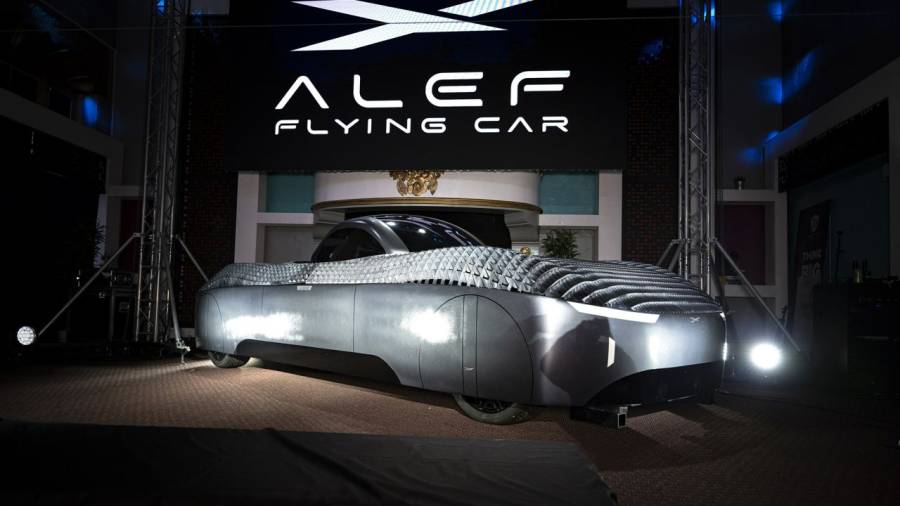The Federal Aviation Administration (FAA) has granted a California startup company called Alef Automotive the first-ever airworthiness permit for a fully electric flying car that is capable of both flying and driving on roads. This milestone event marks the beginning of a new era in the transportation industry. This ground-breaking achievement not only marks a key milestone in the development of flying cars, but it also prepares the way for a new era in the history of mobility. The vehicle produced by Alef Automotive and rightly given the name “Model A” combines the capabilities of vertical takeoff and landing with the ability to drive on highways and park in the same manner as a conventional car. Let’s get into the nitty-gritty of this innovative flying automobile concept and investigate the potential repercussions it could have on the transportation industry.
A revolutionary new mode of transportation is being introduced by Alef Automotive in the form of the Model A, a ground-breaking vehicle that merges the fields of aviation and automotive technology. In contrast to other prototypes of flying cars, the Model A is notable because of its exceptional capability to perform identically well both in the air and on the ground, making it easy to incorporate into regular life. The Model A has the capability of carrying one or two passengers, and it has an excellent road range of 200 miles and a flying range of 110 miles. Because of this, it is an excellent option for traveling over shorter distances, since it enables commutes that are both quicker and more effective for individuals as well as for enterprises.
The certification of the Model A by the Federal Aviation Administration represents a significant step forward in the development of technology for flying cars. The FAA has awarded Alef Automotive with a specialized airworthiness certificate, which grants the company permission to fly for certain, non-commercial objectives, such as research and development. In spite of the fact that other flying car prototypes have also been awarded comparable certifications, the Model A stands out from the competition due to the fact that it can be easily integrated into the current road infrastructure, it resembles a regular automobile, and it can fit into typical parking spaces. This certification is an important validation of the Model A’s safety and reliability, clearing the path for additional testing and, eventually, commercialization of the product.
Obtaining airworthiness certification from the FAA is a huge step forward for Alef Automotive; nevertheless, the company still needs to clear a number of regulatory hurdles before the Model A can be put into production. It is necessary to obtain authorization from the National Highway Traffic Safety Administration in order to guarantee compliance with the criteria for road safety. On the other hand, given that the FAA has given its approval and that there is a rising interest in the technology behind flying cars, it is reasonable to anticipate that regulatory bodies will collaborate closely with innovators in order to set norms and frameworks for this emerging method of transportation.
When looking to the future, the influence that flying automobiles could have on the transportation sector is enormous. These cars have the potential to completely change the way people get around cities, cutting down on traffic congestion and slashing travel times. In times of crisis, they could potentially provide a vital lifeline by facilitating rapid movement in regions where there is inadequate infrastructure. In addition to this, the implementation of electric propulsion systems in flying cars is in line with the worldwide trend toward sustainable transportation, which will result in a reduction in emissions and the amount of damage caused to the environment. If current trends in technological development continue, we can reasonably foresee a future in which flying cars will be a commercially viable and widely used mode of transportation.
The creation of the Model A was a laborious process that took place over a period of several years. Alef Aeronautics Inc. was founded in 2015 by a group of four friends who were motivated to create the company by the vision of the future presented in the “Back to the Future” films. Constantine Kisly, Pavel Markin, Oleg Petrov, and Jim Dukhovny set out on a mission to make flying cars a reality. They were inspired to do so by their enthusiasm for innovation and the conviction that this technology had the potential to completely transform the transportation industry. Their commitment and perseverance resulted to the successful completion of an autonomous test flight for the first time in 2018, followed by the flight of a full-size prototype the following year. These key milestones provided evidence that the Model A could be successfully developed and pushed the project’s progression forward.
The company Alef Automotive has a vision for a future in which flying cars offer an alternative to traditional automobiles that is both more efficient and friendlier to the environment. According to Jim Dukhovny, the Chief Executive Officer of Alef Aeronautics Inc., the Model A marks a big leap forward for both airplanes and cars, enabling the ability for consumers and businesses to save crucial time on their everyday journeys. The Model A aspires to improve commuter experiences by merging the capabilities of air travel and ground travel in order to shorten travel times and provide a method of transportation that is more effective for everyone.
As a result of the numerous pre-orders that Alef Automotive has received, it is clear that the concept of flying automobiles has piqued the interest of people all over the world. In the beginning of this year, the business made the announcement that it had already received more than 400 refundable pre-orders for the Model A. The increasing interest in, and faith in, the concept that flying cars will one day revolutionize the transportation sector is highlighted by the demand for futuristic vehicles like these.
Regarding the cost of the vehicle, Alef Automotive plans to sell the Model A for a price of $300,000 for each individual unit. This price point may appear to be large; nonetheless, it is reflective of the pioneering nature of the technology as well as the significant research and development effort that was required to bring the Model A to market. It is projected that as the technology advances and production levels increase, costs will decrease, making flying cars more affordable to a wider audience.
The Federal Aviation Administration’s (FAA’s) certification that the Alef Automotive Model A is airworthy represents a key milestone in the progression of the development of flying automobiles. This ground-breaking breakthrough paves the way for the integration of aviation and automotive technologies, providing a look into a future in which flying automobiles navigate the skies and highways with the same ease that they do on the ground. In spite of the fact that legal obstacles still need to be overcome, the potential advantages of flying automobiles in terms of better mobility, less congestion, and environmental sustainability are indisputable. As a result of the ongoing development of technology, we are inching closer to the beginning of a new era of transportation, one in which flying automobiles become a reality and completely alter the way in which we move.
The Model A has a road range of 200 miles, a flying range of 110 miles, and the capacity to blend into normal life. Because of these features, it has the potential to revolutionize urban mobility and provide a faster and more efficient commute for individuals as well as enterprises. The future seems promising, and the clouds are pointing us in the direction of a fresh set of transportation opportunities on the horizon.
First reported on CNN


























